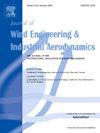基于风量的巷道风阻标定方法
IF 4.9
2区 工程技术
Q1 ENGINEERING, CIVIL
Journal of Wind Engineering and Industrial Aerodynamics
Pub Date : 2025-04-17
DOI:10.1016/j.jweia.2025.106110
引用次数: 0
摘要
通风网络分析是矿井通风系统决策和控制的基础。矿井通风网络各分支的风阻(WR)具有足够小的误差范围是至关重要的。WR通常使用精密气压计通过同步测量方法测量,或者根据巷道参数推导经验公式。在实践中,现场测量往往是费时费力的,经验公式经常引入显著的误差。这种误差使精确气流信息的计算复杂化,从而阻碍了风量的精确控制。在此,我们提出了一种基于风量的道路WR校准方法。该方法利用实测风量和历史风阻数据,建立二次规划优化模型计算等效风阻(EWR)。此外,还对巷道的不等式约束和权值选择进行了讨论和验证。最后进行现场验证(2023年11月马城铁矿)。我们发现,采用WR校正方法后,通风网络计算结果与矿井巷道实际风场分布的吻合程度明显高于未校正的结果。总的来说,我们的方法获得了全局合理的EWR,为风量监测和调节提供了可靠的保证。本文章由计算机程序翻译,如有差异,请以英文原文为准。
A calibrating method of roadway wind resistance based on air volume
Ventilation network analysis is the basis for decision-making and control of mine ventilation system (MVS). It is crucial that the wind resistance (WR) in each branch of the mine ventilation network has a sufficiently small margin of error. WR is typically measured using precision barometers via a simultaneous measurement approach, or it is derived from empirical formulas based on the roadway's parameters. In practice, on-site measurements are often time-consuming and labor-intensive, and empirical formulas frequently introduce significant errors. Such errors complicate the calculation of precise airflow information, thereby impeding the accurate control of air volume. Here, we propose a WR calibrating method for roadways based on air volume. This method establishes a quadratic programming (QP) optimization model to calculate the equivalent wind resistance (EWR), utilizing actual air volume measurements and the historical wind resistance (WR) data. Moreover, the inequality constraints and weight selection of the roadway are discussed and tested. Finally, on-site verification (Ma-cheng Iron Mine in November 2023) was carried on. We find that after our method of WR calibration, the results of the ventilation network calculation were significantly more in line with the actual air distribution in the mine's roadways compared to the results without calibration. Overall, our method obtains the globally reasonable EWR and provides a reliable guarantee for air volume monitoring and regulation.
求助全文
通过发布文献求助,成功后即可免费获取论文全文。
去求助
来源期刊
CiteScore
8.90
自引率
22.90%
发文量
306
审稿时长
4.4 months
期刊介绍:
The objective of the journal is to provide a means for the publication and interchange of information, on an international basis, on all those aspects of wind engineering that are included in the activities of the International Association for Wind Engineering http://www.iawe.org/. These are: social and economic impact of wind effects; wind characteristics and structure, local wind environments, wind loads and structural response, diffusion, pollutant dispersion and matter transport, wind effects on building heat loss and ventilation, wind effects on transport systems, aerodynamic aspects of wind energy generation, and codification of wind effects.
Papers on these subjects describing full-scale measurements, wind-tunnel simulation studies, computational or theoretical methods are published, as well as papers dealing with the development of techniques and apparatus for wind engineering experiments.

 求助内容:
求助内容: 应助结果提醒方式:
应助结果提醒方式:


